ROYAL REGALIA:
THE SYMBOLS OF KINGSHIP
The Royal Regalia lie at the heart of the crowning and investiture part of the coronation ceremony.
The Royal Regalia lie at the heart of the crowning and investiture part of the coronation ceremony.
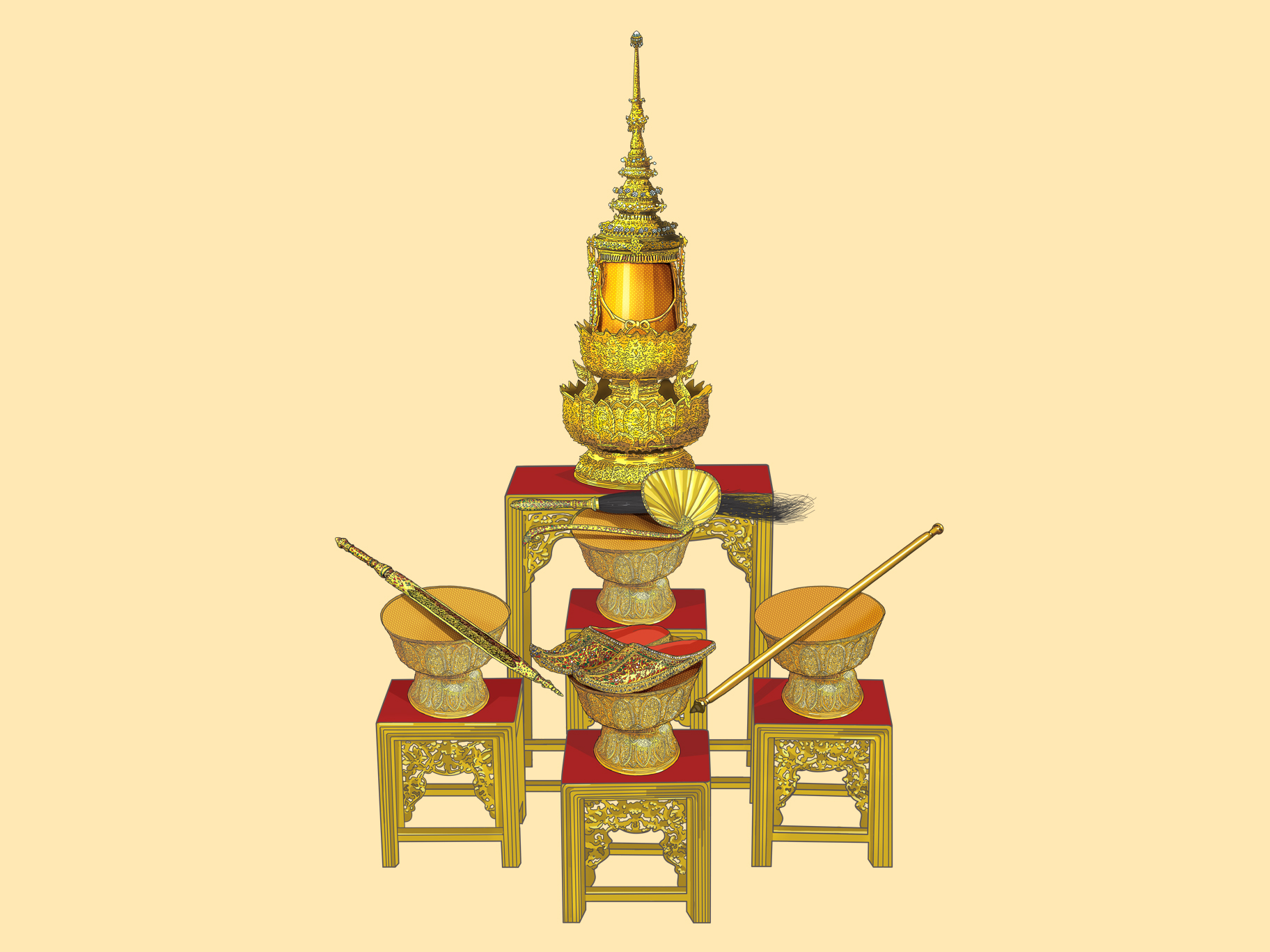
During the rite, the King will be presented with the Royal Regalia, Royal Utensils and Eight Weapons of Sovereignty. Among these 28 regal objects, the Quintet of Royal Regalia or Benjarajakakuthaphan is considered to be prime.
The Quintet of Royal Regalia comprises Phra Maha Phichai Mongkut or the Great Crown of Victory, Phra Saeng Khan Chai Sri or the Sword of Victory, Tharn Phra Korn or the Royal Staff, Walwichani or the Royal Fan and Flywhisk, and the Chalong Phra Baht Cherng Ngorn or the Royal Turned-up Slippers.
In many cases, however, the Nobpadon Maha Sawet Chatr or Nine-tiered Great White Umbrella, placed behind the throne only after the King has been crowned, is regarded as one of the classical quintet.
According to the article “Benjarajakakuthaphan – the Quintet of Royal Regalia” published in the Bangkok Post on December 5, 1985, the Royal Regalia, each of which was ornately made with gold, diamonds and other precious stones with the finest craftsmanship dating back to the reign of King Rama I, the founder of the Chakri Dynasty, serve to demonstrate the King’s majestic authority and to command from people the respect due to kingship.
In their majestic splendour, the regal accessories also carry symbolic meanings of what it means to be King. Each of the 28 items epitomise the royal tie, the king’s burden and obligation towards the people.
The primary emblem of kingship, the Great Crown of Victory, is a multi-tiered, conical diadem made of gold and diamonds. It weighs 7.3kg.
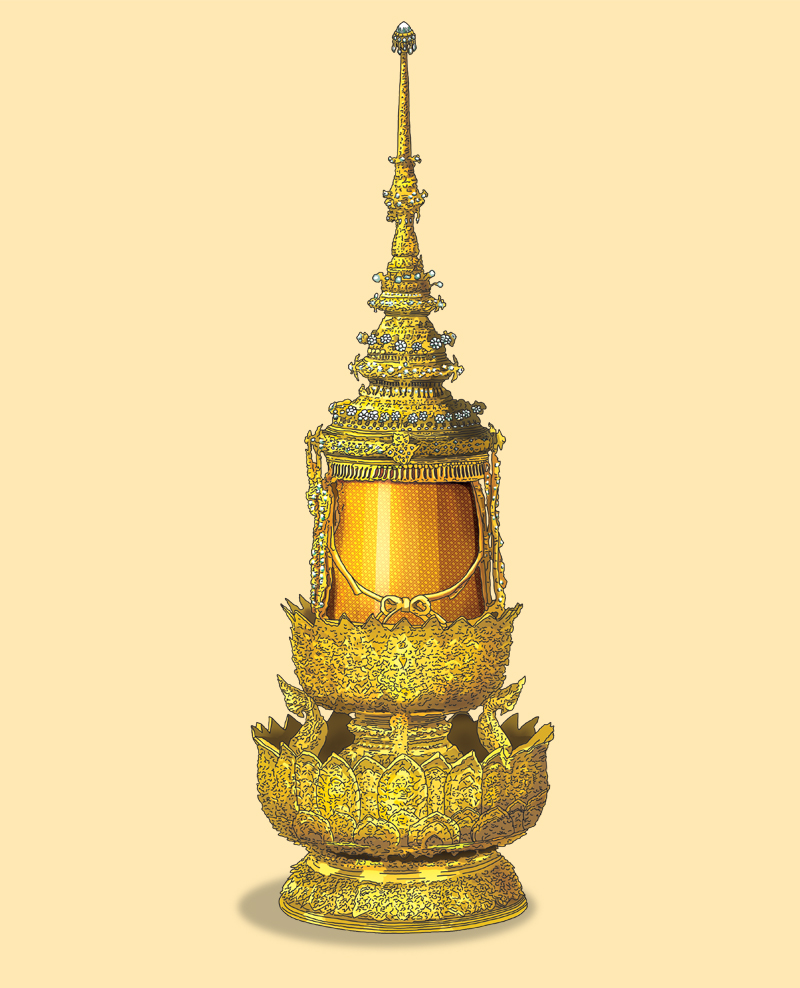
Before the early Rattanakosin era, the crown was considered as important as the other items in the Royal Regalia. However, during the reign of King Rama IV, when the then Kingdom of Siam started to foster relations with European nations, the country adopted the western tradition of treating the crown as the representation of the throne.
Since the Fourth Reign, the moment the King crowned himself with the Great Crown of Victory presented to him by the Chief Brahmin is considered the highpoint of the coronation.
The crowning moment is immediately followed by the blowing of conch shells and the sounding of small, hour-glass-shaped drums from Brahmin priests, a fanfare within the Grand Palace and the firing of salutes outside the wall.
The Great Crown of Victory is exemplary of Thai traditional design and exquisite craftsmanship. The 66-cm spire is adorned with intricate gold ornaments and embellished with red, green and sky blue rajawadi enamelling.
Phra Maha Phichai Mongkut was skilfully crafted by expert artisans during the reign of King Rama I. The crown attests to the cultural heritage of a nation that has the highest respect for the dignity of the leader whom it regards as worthy of the greatest honour.
Phra Saeng Khan Chai Sri, the Sword of Victory, serves to remind people of the king’s traditional role as a warrior protecting the kingdom. The weapon is also emblematic of the king’s valour and his supreme power as the ruler.
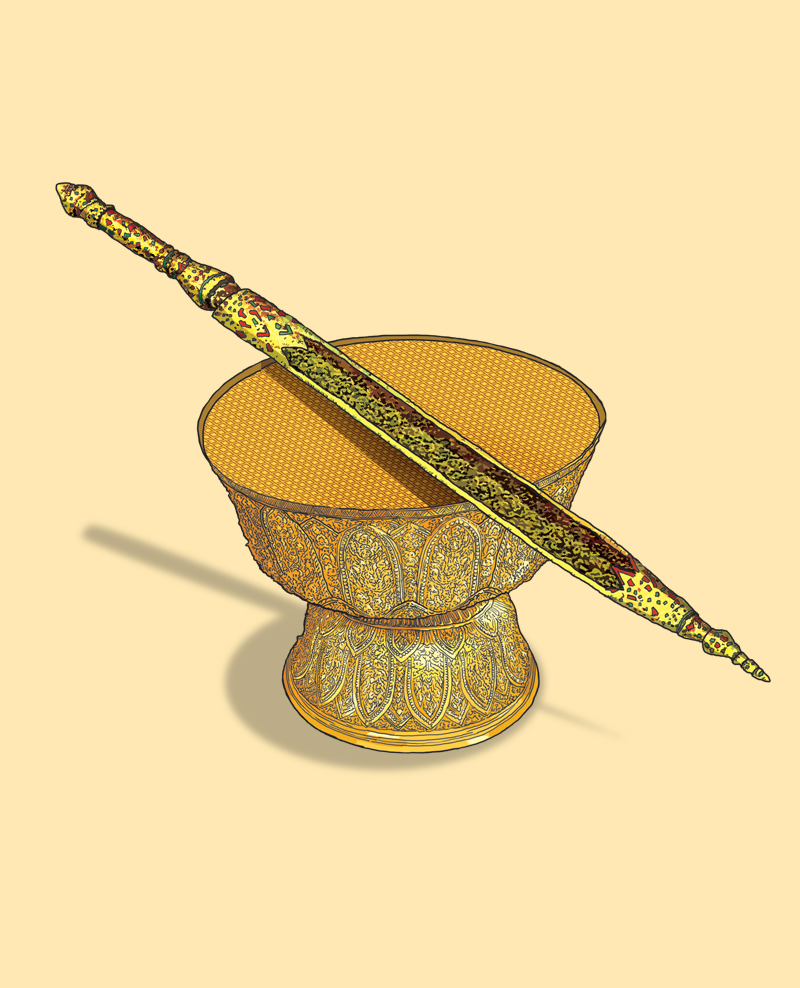
Interestingly, this key item in the royal regalia came from Cambodia. The ancient double-edged blade was found in a lake at Siem Reap by a local fisherman before Chao Phraya Abhaiphubet who was delegated to administer the affairs of Kampuchea, at that time a Thai protectorate, had it sent to King Rama I.
On royal command, a hilt and scabbard was made for the blade. They were made of gold elaborately decorated with rajawadi enamelling and encrusted with precious stones.
Near the hilt, the blade is decorated with engravings depicting various deities, entities and animals referred to in the Vedas which serve to illustrate the symbolic power and glory of the king.
Tharn Phra Korn, the Royal Staff, is a symbol of regal authority by many cultures worldwide. It is associated with longevity and boundless wisdom, the guiding of the king's footsteps down the path of justice and equity.
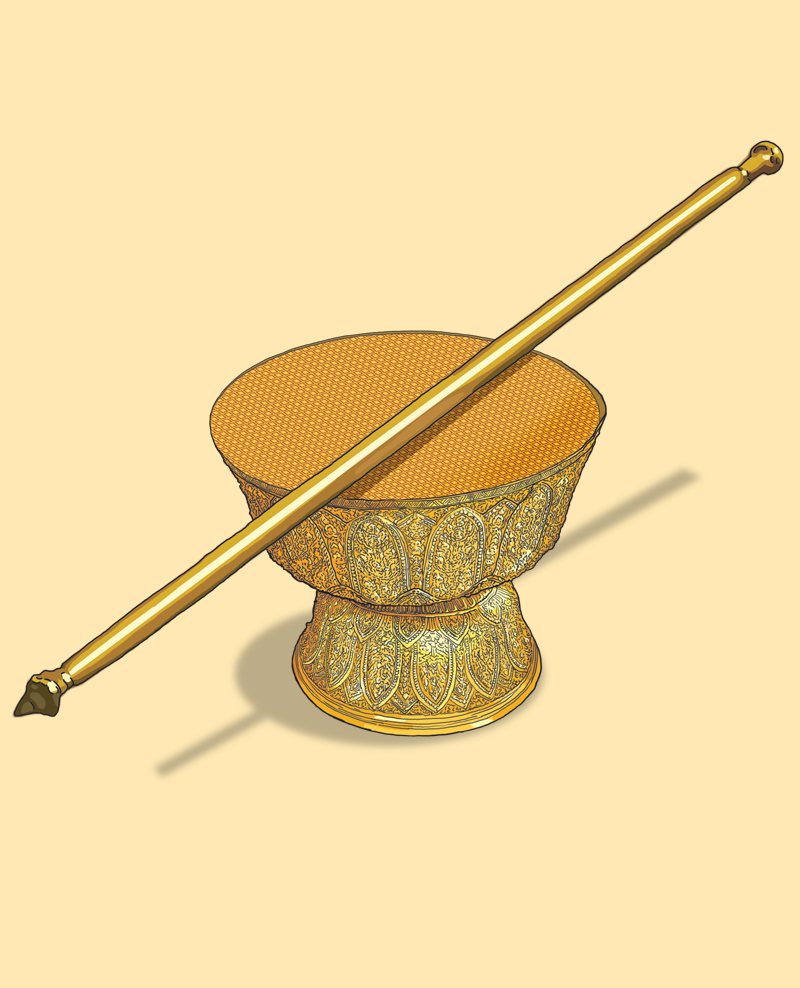
A Silpakorn University’s study on the Royal Regalia stipulated that the Royal Staff was originally made of cassia wood enclosed in gold sheeting. The Staff featured a knob at the top and three tines at the foot. It was known as the Cassia Royal Staff.
During the reign of King Rama IV, a new version of the Royal Staff was made of gold. The staff was encased with a throwing knife and capped with a deity figure at its top knob. Although the new Royal Staff appeared more like a sword outwardly, it was known as the Deity Royal Staff.
King Rama VI, however, reversed the tradition and had the Cassia Royal Staff reinstalled as one of the Royal Regalia, where it has stayed until today.
The Royal Fan and Flywhisk symbolise the King’s ability to dispel misfortune from his subjects and to keep them in comfort and well-being.
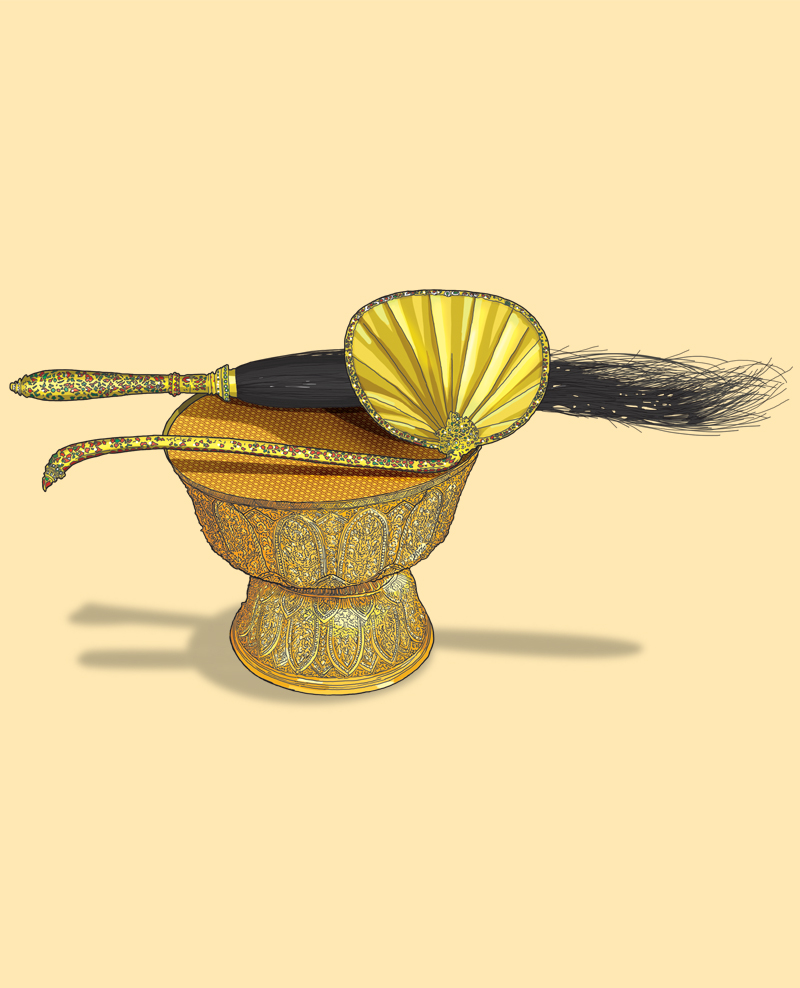
During the reign of King Rama I, Walwichani only meant the Royal Fan. Later, however, King Rama IV, who was well-versed in Pali and Sanskrit, reasoned that the word “walwichani” could be more accurately translated as a flywhisk made of animal hair.
The Fourth King thus ordered a Royal Whisk made from a yak’s tail and incorporated into the Walwichani.
At the Coronation Ceremony of the late King Bhumibol Adulyadej, the Royal Flywhisk made from tail-hairs of an albino elephant was used and presented to him together with the Royal Fan since the yak's tail-hairs had deteriorated.
Measured at 29cm in length and 12cm in width, Chalong Phra Baht Cherng Ngorn or the Royal Turned-on Slippers were crafted in gold with red, green and white rajawadi enamelling, set with emeralds and zircons along the sides, the edges, and down the centre ribs of the slippers.
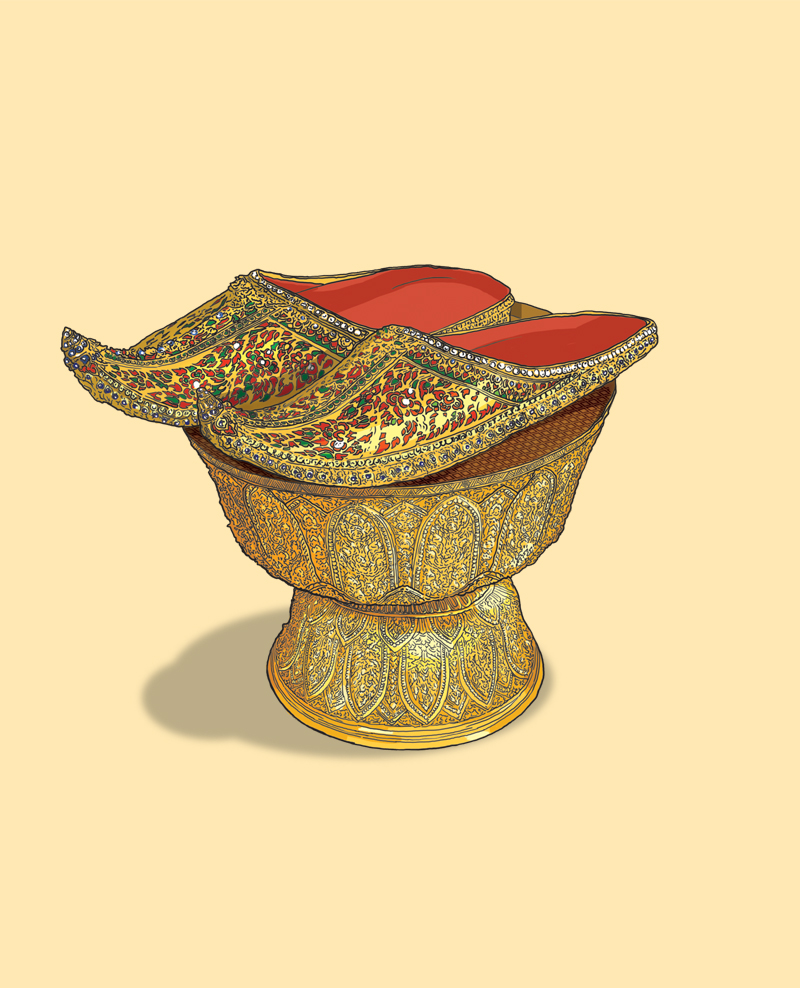
The Royal Slippers are emblematic of the King’s majesty which would be evident everywhere he sets foot on. The slippers also represent the royal burden, as expansive and heavy as the size and weight of the land itself.
According to a Jataka tale on which the epic Ramayana is based, Prince Rama gave a pair of slippers to his half-brother Prince Bharata and turned down the latter’s invitation for him to ascend the throne.
Prince Bharata then placed the slippers on the throne as a symbol of the king.
(Sources: “Bencharajakakuthaphan: the Quintet of Royal Regalia”, Mom Rajawongse Putrie Viravaididya, Bangkok Post/World Supplement, December 5, 1985; “Royal Regalia for the Coronation of Kings in the Rattanakosin Era”, Buraya Sraphaivanich, Independent Study for a Master of Arts, Archaeology Department, Silpakorn University, 2013.)
(Graphics: Pirada Jaokaew)
